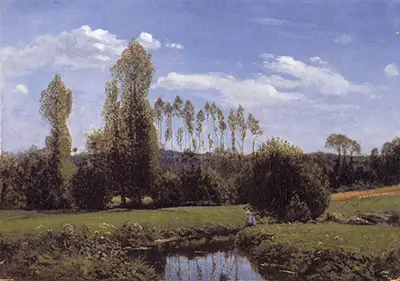At the time, he used the en plein air painting technique learnt from his then mentor - Eugene Bouldin. The piece brings out Claude's photographic eye for nature, featuring a striking depth of colour and delicate brushstrokes.
Claude Monet’s work was largely characterised by the famous Impressionism style. This style meant that light and colour created the forefront of all his paintings. At the time, he and other painters sought to depict life in a unique style; where the primary subjects were nature (sun or the moon) bathed in different types of light.
The goal was to portray colour and light in artistic ways. Monet’s quest to depict this aspect of art made him famous at the time with his work being displayed in some locations in central Europe and the Mediterranean. It was Monet’s work that birthed an artistic movement esteemed to date.
Considered an exemplary figure in the philosophy of Impressionism, Claude was born in 1840 in Paris. He later moved to Le Havre when he was only five years old. Sadly his parents and teachers considered him unruly, hence unlikely to succeed in life.
In fact, he spent most of his time creating comic strips, which saw him receive a commission for his work by the time he turned fifteen. It was then that he met Eugene Boudin, the initiator and stanch advocate of the Impressionist style.
Initially, Monet’s work was credited to the Realist’s style, which lacked life and idealisation. As a result, he painted outdoors to capture the short-lived qualities of nature. Later, Monet departed from creating plain forms and experimented with bold colours, loose handling and extraordinarily unusual creations. Famous realist artists include Edward Hopper, Ilya Repin and Gustave Courbet. William-Adolphe Bouguereau was a significant remember of the closely-related Academic art movement.
Inspired by Edouard Manet, a Realism and Expressionism artist, Monet’s work changed from drawing plain figures to displaying different qualities of light and the atmosphere in every scene. It was at this time that Claude valued the use of decorative colours and form. Later, he embarked on applying paint using small strokes and building it up to vast fields of colour while exploring the potential of using contrasting shades. The paintings created during this period are evident in his 1890s series, which is characterised by a remarkable focus on surface effects and abstraction.
Camille Monet et un enfant au jardin - The painting displays Camille, his first wife with a child in the garden of their home in Argenteuil. Prior to his venture in landscape painting, Monet’s focus was on portraits. Camille appears on most of Monet’s work, and this particular piece was painted when women’s portraits were ordered by middle-class clients. At the time, the artistic structure of the painting was more important than the identity of the person in the portrait. This particular piece expresses a lot of simplicity of the colours and masterly of style, which gives a new directness of the impressionism style.
Impression, Sunrise - The painting was first displayed in an exhibition in 1874. It was this painting’s name that elicited the description of most of Monet’s painting style-Impressionism. An art critic Louis Leroy derived the term Impressionistic from the painting’s title. The word became all the rage as other artists painted and displayed other such pieces, hence the term Impressionist artists. Sadly, this piece was stolen in 1985 from Musee Marmottan, but it was recovered and put back on display in 1991 at the museum.



